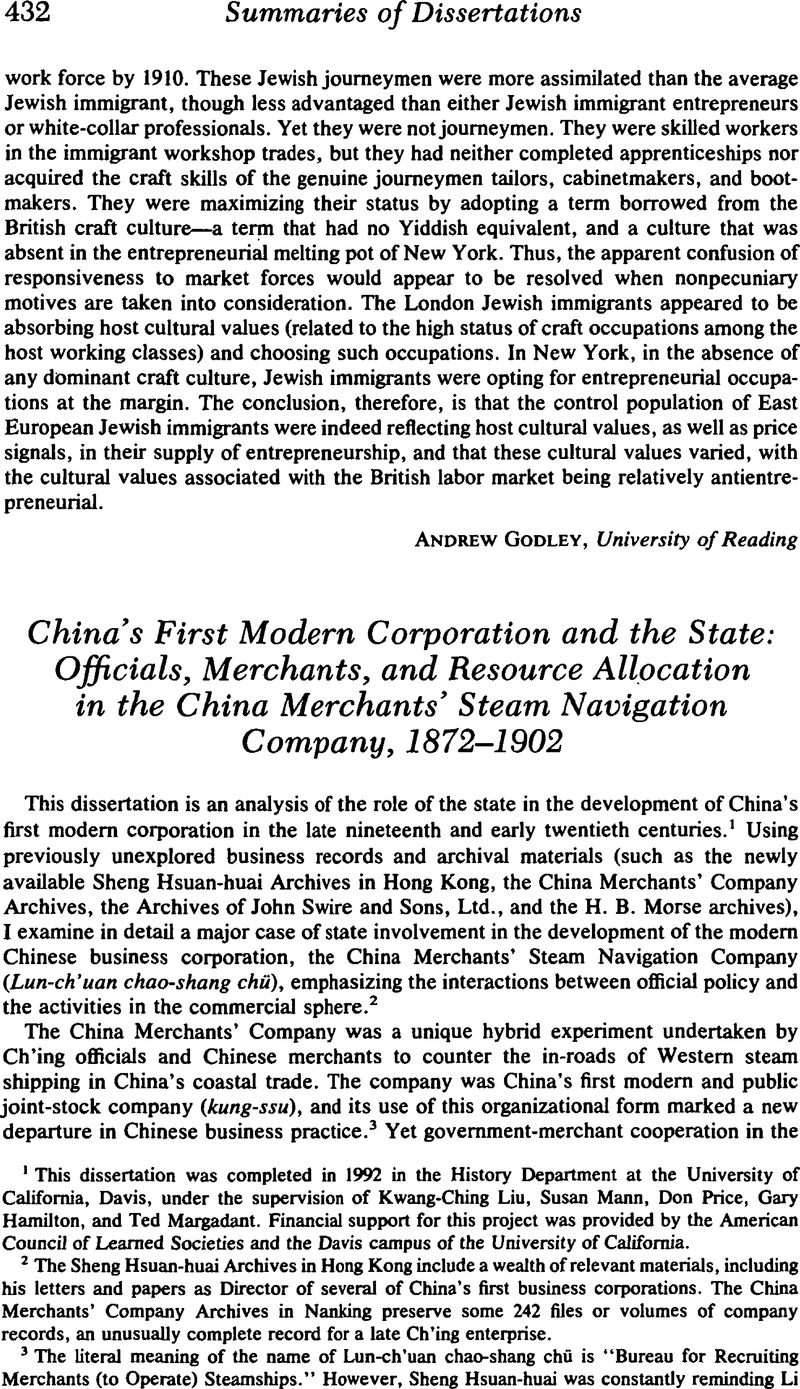Published online by Cambridge University Press: 03 March 2009

1 This dissertation was completed in 1992 in the History Department at the University of California, Davis, under the supervision of Kwang-Ching Liu, Susan Mann, Don Price, Gary Hamilton, and Ted Margadant. Financial support for this project was provided by the American Council of Learned Societies and the Davis campus of the University of California.
2 The Sheng Hsuan-huai Archives in Hong Kong include a wealth of relevant materials, including his letters and papers as Director of several of China's first business corporations. The China Merchants' Company Archives in Nanking preserve some 242 files or volumes of company records, an unusually complete record for a late Ch'ing enterprise.
3 The literal meaning of the name of Lun-ch'uan chao-shang chū is “Bureau for Recruiting Merchants (to Operate) Steamships.” However, Sheng Hsuan-huai was constantly reminding Li Hung-chang that “the China Merchants' Company is China's first pioneering business corporation (kung-ssu).” See Sheng Hsuan-huai Archives (H.K.), Sheng's Letters to Li Hung-chang, 1879.
4 Li Hung-chang (1823–1901) was one of the most influential statesmen of nineteenth-century China. For the latest studies of Li Hung-chang, see Shu-i, Yüan, Li Hung-chang chuan (Biography of Li Hung-chang) (Peking, 1991)Google Scholar; Chün, Chou and Yü-jun, Yang, eds., Li Hung-chang yü Chung-kuo chin-tai hua (Li Hung-chang and China's Modernization) (Hefei, 1989)Google Scholar; and the articles in Chu, Samuel C. and Liu, Kwang-Ching, eds., Li Hung-chang and China's Early Modernization (Armonk, NY, 1994).Google Scholar Newly available materials and unpublished documentary sources (such as Ch'in-pi hsin kao [Li's unpublished personal letters in his own hand]) promise to deepen our understanding of Li's role in the development of modern enterprises. For references on Li, see Samuel C. Chu, “Li Hung-chang: An Assessment,” in Li Hung-chang and China's Early Modernization, Conclusion.
5 Hung-chang, Li, Li Wen-chung-kung ch'üan-chi: Tsou-kao (Complete Collection of Li Hung-chang's Papers: Memorials) (Nanking, 1905), vol. 20, p. 33; vol. 36, p. 35.Google Scholar
6 There is already a considerable amount of literature to which Chinese, Japanese, and Westerners have contributed on the role of the state in the development of Chinese enterprises in the late nineteenth century. Among the most important are studies by Albert Feuerwerker, Kwang-Ching Liu, Wellington K. K. Chan, Yen-p'ing Hao, Chen Jiang, Hsia Tung-yuan (Xia Dongyuan), and Chang Kuo-hui (Zhang Guohui). Generally the tendency is to emphasize the China Merchants' Company's and Li Hung-chang's contributions and limitations, especially in comparison with developments taking place in Meiji Japan, casting China's early modernization efforts in an unfavorable light. See Lai, Chi-kong “Tzu-ch'iang yun-tung” (recent historiography on the self-strengthening movement) in Scholarship on Modern Chinese History During the Past Six Decades (Taipei, 1989), vol. 2, pp. 691–718Google Scholar; Jiang, Chen, “Recent Chinese Historiography on the Western Affairs Movement (Yangwu yundong ca. 1860–1895),” in Late Imperial China, 7 (1986), pp. 112–127Google Scholar; Kennedy, Thomas L., “Self-Strengthening: An Analysis Based on Some Recent Writings,” in Ch'ing-shih wen-tsi, 3.1 (1974), pp. 3–35.Google Scholar